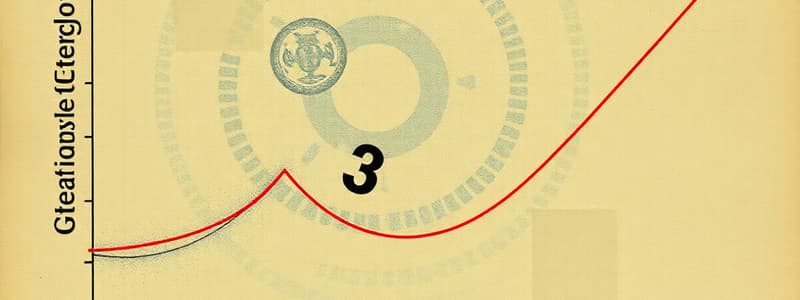Podcast
Questions and Answers
Quel effet peut résulter d'un déplacement simultané vers la droite des courbes AD et AS ?
Quel effet peut résulter d'un déplacement simultané vers la droite des courbes AD et AS ?
- Une augmentation de la production avec des niveaux de prix stables ou en hausse. (correct)
- Une hausse de la production avec une augmentation du chômage.
- Une diminution de la production avec un niveau de prix en baisse.
- Une baisse significative de la production et des prix.
Quels facteurs peuvent influencer le déplacement de la courbe d'offre agrégée (AS) ?
Quels facteurs peuvent influencer le déplacement de la courbe d'offre agrégée (AS) ?
- La confiance des consommateurs.
- Les avancées technologiques. (correct)
- Les taux d'intérêt.
- Les dépenses gouvernementales.
Quelles implications peuvent avoir les déplacements simultanés des courbes AD et AS pour les décideurs politiques ?
Quelles implications peuvent avoir les déplacements simultanés des courbes AD et AS pour les décideurs politiques ?
- Ils doivent ignorer les changements pour éviter de provoquer des réactions excessives.
- Ils doivent uniquement réagir aux variations des prix.
- Ils doivent comprendre les causes sous-jacentes pour mieux stimuler la production. (correct)
- Ils devraient se concentrer uniquement sur la courbe d'offre agrégée.
Quel scénario pourrait indiquer un déplacement simultané vers la gauche des courbes AS et AD ?
Quel scénario pourrait indiquer un déplacement simultané vers la gauche des courbes AS et AD ?
Lequel des éléments suivants est le moins susceptible d'influencer les déplacements de la courbe de demande agrégée (AD) ?
Lequel des éléments suivants est le moins susceptible d'influencer les déplacements de la courbe de demande agrégée (AD) ?
Quel est l'impact d'un déplacement à droite de la courbe d'offre globale (AS) sur le niveau de prix et la production réelle ?
Quel est l'impact d'un déplacement à droite de la courbe d'offre globale (AS) sur le niveau de prix et la production réelle ?
Quelles conditions peuvent entraîner un déplacement à gauche de la courbe de demande globale (AD) ?
Quelles conditions peuvent entraîner un déplacement à gauche de la courbe de demande globale (AD) ?
Qu'est-ce qui peut provoquer un déplacement à droite de la courbe d'offre globale (AS) ?
Qu'est-ce qui peut provoquer un déplacement à droite de la courbe d'offre globale (AS) ?
Quel effet a une diminution simultanée de la courbe AS et de la courbe AD sur l'équilibre du marché ?
Quel effet a une diminution simultanée de la courbe AS et de la courbe AD sur l'équilibre du marché ?
Quel processus économique peut être caractérisé par un déplacement à gauche de la courbe AS ?
Quel processus économique peut être caractérisé par un déplacement à gauche de la courbe AS ?
Comment un déplacement à droite de la courbe AD influence-t-il le niveau de prix et la production réelle ?
Comment un déplacement à droite de la courbe AD influence-t-il le niveau de prix et la production réelle ?
Quelle conséquence peut engendrer un déplacement à gauche de la courbe de demande globale (AD) sur le marché ?
Quelle conséquence peut engendrer un déplacement à gauche de la courbe de demande globale (AD) sur le marché ?
Si on observe une augmentation du coût de production due à des facteurs externes, quel type de déplacement de la courbe d'offre globale serait observé ?
Si on observe une augmentation du coût de production due à des facteurs externes, quel type de déplacement de la courbe d'offre globale serait observé ?
Flashcards
AS Curve Shift
AS Curve Shift
Change in economy's ability to produce goods/services at different price levels.
AD Curve Shift
AD Curve Shift
Change in total demand for goods/services at various price levels.
Rightward AS Shift
Rightward AS Shift
Increased production capacity, higher output at each price.
Leftward AS Shift
Leftward AS Shift
Signup and view all the flashcards
Rightward AD Shift
Rightward AD Shift
Signup and view all the flashcards
Leftward AD Shift
Leftward AD Shift
Signup and view all the flashcards
Equilibrium Shift
Equilibrium Shift
Signup and view all the flashcards
Simultaneous Shifts
Simultaneous Shifts
Signup and view all the flashcards
Simultaneous AD/AS shifts
Simultaneous AD/AS shifts
Signup and view all the flashcards
AS Curve Shifts
AS Curve Shifts
Signup and view all the flashcards
AD Curve Shifts
AD Curve Shifts
Signup and view all the flashcards
Policy Implications (AD/AS)
Policy Implications (AD/AS)
Signup and view all the flashcards
Macroeconomic Variables
Macroeconomic Variables
Signup and view all the flashcards
Study Notes
Shifts in the AS/AD Curves
-
Shifts in the Aggregate Supply (AS) curve represent changes in the economy's ability to produce goods and services at different price levels. These shifts are driven by factors affecting the overall cost of production.
-
Shifts in the Aggregate Demand (AD) curve represent changes in the total demand for goods and services in the economy at various price levels. These changes are influenced by factors affecting consumer and business spending and investment.
-
Rightward shift of the AS curve: An increase in the economy's potential output, often driven by factors like technological advancements, increased labor supply, or capital accumulation, leads to higher output at each price level. This is often associated with economic growth.
-
Leftward shift of the AS curve: A decrease in the economy's potential output, due to factors such as natural disasters, supply chain disruptions, or labor shortages, results in lower output at each price level, often leading to stagflation (high inflation and low growth).
- This shift usually raises input costs.
-
Rightward shift of the AD curve: Increased consumer and business confidence, lower interest rates, or government spending boosts total demand, leading to higher aggregate demand at each price level. This often indicates expansionary economic policy. Increased money supply can have a similar effect.
-
Leftward shift of the AD curve: Decreased consumer and business confidence, higher interest rates, tax increases, reduced government spending can lower aggregate demand at each price level. This often indicates contractionary economic policy. A decrease in the money supply has a similar effect.
-
Impact on equilibrium: Shifts in either the AS or AD curve lead to a new equilibrium point characterized by a different price level and real output.
-
Price level and output effects of AS/AD shifts:
- A rightward shift of the AD curve results in a higher price level and higher real output.
- A leftward shift of the AD curve results in a lower price level and lower real output.
- A rightward shift of the AS curve results in a lower price level and higher real output.
- A leftward shift of the AS curve results in a higher price level and lower real output.
-
Simultaneous shifts: It's essential to understand the combined effects of simultaneous shifts in both the AS and AD curves. These simultaneous shifts can lead to complex and unpredictable outcomes based on the size and direction of each shift. Example:
- A simultaneous rightward shift in both AD and AS curves can lead to higher output and potentially higher or stable price levels, depending on the magnitude of the shifts.
- A simultaneous leftward shift in AS and AD signifies a more complex scenario, potentially indicating lower output and a lower price level. The overall effect is dependent on the relative magnitudes of the shifts.
-
Policy implications: Understanding the effects of these shifts is crucial for policymakers to effectively manage the economy. For example, if policymakers observe a leftward shift in the aggregate supply curve, they might need to address the underlying causes to stimulate production and prevent potential economic slowdowns.
-
Interaction with other macroeconomic variables: The interplay between AS/AD shifts and other macroeconomic variables like unemployment, interest rates, and inflation must be considered for a comprehensive understanding of economic performance and policy response.
-
Key factors influencing AS shifts:
- Technology advancements
- Changes in input costs (e.g., raw materials)
- Changes in labor productivity
- Government regulations
- Supply chain disruptions
-
Key factors influencing AD shifts:
- Consumer confidence
- Business investment
- Government spending
- Interest rates
- Money supply
- Exchange rates
Studying That Suits You
Use AI to generate personalized quizzes and flashcards to suit your learning preferences.




